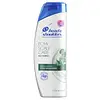Neutrogena T/Gel Sensitive Scalp Anti-Dandruff Shampoo Versus Head & Shoulders Itchy Scalp Care with Eucalyptus Anti-Dandruff Shampoo
What's inside
What's inside
 Key Ingredients
Key Ingredients

No key ingredients
 Benefits
Benefits

No benefits
 Concerns
Concerns

 Ingredients Side-by-side
Ingredients Side-by-side

Water
Skin ConditioningSodium Laureth Sulfate
CleansingGlycerin
HumectantCocamidopropyl Betaine
CleansingSodium Chloride
MaskingSalicylic Acid
MaskingPiroctone Olamine
PreservativeHydroxypropyl Guar Hydroxypropyltrimonium Chloride
Benzotriazolyl Dodecyl P-Cresol
UV AbsorberTris(Tetramethylhydroxypiperidinol)Citrate
StabilisingPolyquaternium-39
Alcohol
AntimicrobialCocamide Mea
EmulsifyingCitric Acid
BufferingSodium Benzoate
MaskingWater, Sodium Laureth Sulfate, Glycerin, Cocamidopropyl Betaine, Sodium Chloride, Salicylic Acid, Piroctone Olamine, Hydroxypropyl Guar Hydroxypropyltrimonium Chloride, Benzotriazolyl Dodecyl P-Cresol, Tris(Tetramethylhydroxypiperidinol)Citrate, Polyquaternium-39, Alcohol, Cocamide Mea, Citric Acid, Sodium Benzoate
Zinc Pyrithione 1%
AntiseborrhoeicWater
Skin ConditioningSodium Lauryl Sulfate
CleansingSodium Laureth Sulfate
CleansingGlycol Distearate
EmollientZinc Carbonate
Sodium Chloride
MaskingSodium Xylenesulfonate
Parfum
MaskingCocamidopropyl Betaine
CleansingDimethicone
EmollientSodium Benzoate
MaskingGuar Hydroxypropyltrimonium Chloride
Skin ConditioningMagnesium Carbonate Hydroxide
BufferingMentha Piperita Oil
MaskingMenthol
MaskingMentha Arvensis Leaf Oil
MaskingEucalyptus Globulus Leaf Extract
PerfumingMethylchloroisothiazolinone
PreservativeMethylisothiazolinone
PreservativeZinc Pyrithione 1%, Water, Sodium Lauryl Sulfate, Sodium Laureth Sulfate, Glycol Distearate, Zinc Carbonate, Sodium Chloride, Sodium Xylenesulfonate, Parfum, Cocamidopropyl Betaine, Dimethicone, Sodium Benzoate, Guar Hydroxypropyltrimonium Chloride, Magnesium Carbonate Hydroxide, Mentha Piperita Oil, Menthol, Mentha Arvensis Leaf Oil, Eucalyptus Globulus Leaf Extract, Methylchloroisothiazolinone, Methylisothiazolinone
Ingredients Explained
These ingredients are found in both products.
Ingredients higher up in an ingredient list are typically present in a larger amount.
Cocamidopropyl Betaine is a fatty acid created by mixing similar compounds in coconut oil and dimethylaminopropylamine, a compound with two amino groups.
This ingredient is a surfactant and cleanser. It helps gather the dirt, pollutants, and other impurities in your skin to be washed away. It also helps thicken a product and make the texture more creamy.
Being created from coconut oil means Cocamidopropyl Betaine is hydrating for the skin.
While Cocamidopropyl Betaine was believed to be an allergen, a study from 2012 disproved this. It found two compounds in unpure Cocamidopropyl Betaine to be the irritants: aminoamide and 3-dimethylaminopropylamine. High-grade and pure Cocamidopropyl Betaine did not induce allergic reactions during this study.
Learn more about Cocamidopropyl BetaineSodium Benzoate is a preservative. It's used in both cosmetic and food products to inhibit the growth of mold and bacteria. It is typically produced synthetically.
Both the US FDA and EU Health Committee have approved the use of sodium benzoate. In the US, levels of 0.1% (of the total product) are allowed.
Sodium benzoate works as a preservative by inhibiting the growth of bacteria inside of cells. It prevents the cell from fermenting a type of sugar using an enzyme called phosphofructokinase.
It is the salt of benzoic acid. Foods containing sodium benzoate include soda, salad dressings, condiments, fruit juices, wines, and snack foods.
Studies for using ascorbic acid and sodium benzoate in cosmetics are lacking, especially in skincare routines with multiple steps.
We always recommend speaking with a professional, such as a dermatologist, if you have any concerns.
Learn more about Sodium BenzoateChances are, you eat sodium chloride every day. Sodium Chloride is also known as table salt.
This ingredient has many purposes in skincare: thickener, emulsifier, and exfoliator.
You'll most likely find this ingredient in cleansers where it is used to create a gel-like texture. As an emulsifier, it also prevents ingredients from separating.
There is much debate on whether this ingredient is comedogenic. The short answer - comedogenic ratings don't tell the whole story. Learn more about comegodenic ratings here.
The concensus about this ingredient causing acne seems to be divided. Research is needed to understand if this ingredient does cause acne.
Scrubs may use salt as the primary exfoliating ingredient.
Learn more about Sodium ChlorideSodium Laureth Sulfate (SLES) is a foaming, cleansing, and emulsifying ingredient. It is created from palm kernel oil or coconut oil. SLES is not the same as sodium lauryl sulfate. It is much milder and less likely to irritate.
SLES helps create foam in personal products. It also prevents ingredients from separating, helping to elongate the shelf life.
Sodium Laureth Sulfate is a type of sulfate. It can be drying. We recommend speaking with a professional about using this ingredient if you have concerns.
Learn more about Sodium Laureth SulfateWater. It's the most common cosmetic ingredient of all. You'll usually see it at the top of ingredient lists, meaning that it makes up the largest part of the product.
So why is it so popular? Water most often acts as a solvent - this means that it helps dissolve other ingredients into the formulation.
You'll also recognize water as that liquid we all need to stay alive. If you see this, drink a glass of water. Stay hydrated!
Learn more about Water